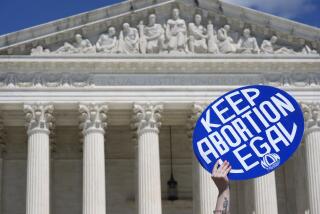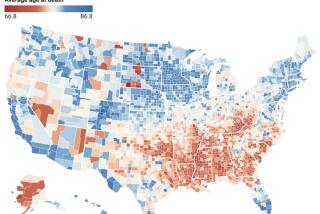American Infertility Rate Not Growing, Study Finds
WASHINGTON — Despite a widespread perception that infertility is rapidly increasing in the United States, the rate actually has remained stable in recent years, government researchers reported Thursday.
In 1988, 4.9 million American women between the ages of 15 and 44 had “an impaired ability” to have children, according to a study by the National Center for Health Statistics. That represents 8.4% of women in that age group--the same percentage as in 1982.
The mistaken perception that the United States is experiencing an “epidemic of infertility” could reflect demographic and social changes affecting some groups of women more than others, the study suggested.
For example, the number of childless women between 25 and 44 with impaired ability to conceive and carry a child to term has increased significantly “because of delayed childbearing and the entry of the baby-boom cohorts into the age range,” the study said.
“The increased use of fertility services, the increased number of childless older women with impaired fecundity and other factors may help to account for the perception that infertility is increasing or that it is more common than it actually is,” the study said.
Infertility is frequently defined as the inability to become pregnant after at least a year of trying. Fecundity is a measure of both the ability to conceive and the ability to carry a pregnancy to term.
The study said that about 2.2 million women who had never had children had impaired fecundity in 1988, along with 2.7 million women who had given birth at least once. In 1982, the figures were 1.9 million and 2.6 million respectively, the study said.
Among married couples, the overall percentage of infertility decreased from 11.2% in 1965 to 8.5% in 1982 and to 7.9% in 1988, the study said.
About 2.3 million married women between the ages of 15 and 44 were infertile in 1988, or slightly fewer than 1 in 12, the study said. These figures were not significantly different from the findings in 1982, the study said.
“The number of women suffering from infertility has increased, but the population base has also increased. The incidence of infertility has not,” said Joyce Zeitz, a spokeswoman for the American Fertility Society.
Zeitz said she was not surprised by the study’s findings.
“We started hearing this so-called ‘epidemic’ story but when we started thinking it through we said, no, it’s not going to wash,” she said. “The reality is that there’s more help available and more publicity about help. Therefore, more people are actively seeking help. There’s a greater awareness out there, right down the line.”
The study results are based on a series of surveys conducted periodically by the National Center for Health Statistics, a branch of the Department of Health and Human Services. The 1988 survey involved personal interviews with 8,450 women.
“In some popular descriptions of infertility, it has been suggested that there are 9 or 10 million infertile couples, that 1 in 6 couples is infertile, that infertility is increasing rapidly, or that there is an ‘epidemic’ of infertility in the United States,” the report said. “The findings of this report indicate that these perceptions are inaccurate.”






